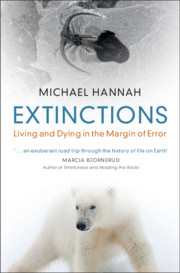Book contents
- Extinctions
- Reviews
- Extinctions
- Copyright page
- Epigraph
- Dedication
- Contents
- Preface
- Acknowledgements
- Further Reading
- Introduction
- 1 The Anthropocene and the Earth System
- 2 A Short Detour: The Fossil Record and the Geological Time Scale
- 3 The Origin of Animals and the Emergence of the Earth System
- 4 Documenting Ancient Biodiversity
- 5 Mass Extinctions: The Basics
- 6 Causes of the End-Permian and End-Cretaceous Extinction Events
- 7 Time Heals All: Recovering from a Mass Extinction
- 8 The Late Quaternary Megafaunal Extinctions
- 9 Surviving the Anthropocene
- Book part
- Further Reading
- Index
1 - The Anthropocene and the Earth System
Published online by Cambridge University Press: 01 September 2021
- Extinctions
- Reviews
- Extinctions
- Copyright page
- Epigraph
- Dedication
- Contents
- Preface
- Acknowledgements
- Further Reading
- Introduction
- 1 The Anthropocene and the Earth System
- 2 A Short Detour: The Fossil Record and the Geological Time Scale
- 3 The Origin of Animals and the Emergence of the Earth System
- 4 Documenting Ancient Biodiversity
- 5 Mass Extinctions: The Basics
- 6 Causes of the End-Permian and End-Cretaceous Extinction Events
- 7 Time Heals All: Recovering from a Mass Extinction
- 8 The Late Quaternary Megafaunal Extinctions
- 9 Surviving the Anthropocene
- Book part
- Further Reading
- Index
Summary
The first chapter introduces a new geological period – the Anthropocene – and explains its origins its timing and importance in emphasizing the current biotic crisis. The current idea that we are in the sixth extinction is criticized because (1) the current level of extinction isn’t high enough to justify it and (2) it limits today’s biotic crisis to just those species that have gone extinct and does not include those under threat. The term defaunation is used in preference because it provides a clearer picture of the situation we find ourselves in. It does this by including both species that have gone extinct and those under threat of extinction. The important concept of the Earth System is outlined and its role in maintaining planetary conditions explained. The link between sudden shifts in Earth System due to climatic forcings and mass extinctions is explained.
Keywords
- Type
- Chapter
- Information
- ExtinctionsLiving and Dying in the Margin of Error, pp. 11 - 28Publisher: Cambridge University PressPrint publication year: 2021

